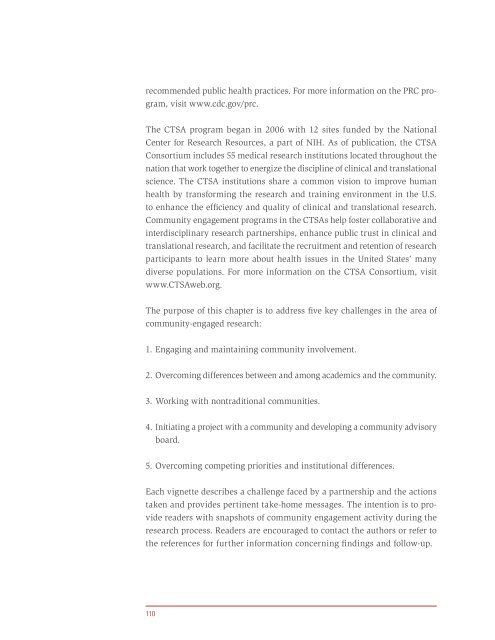Principles of Community Engagement (Second Edition)
Principles of Community Engagement (Second Edition)
Principles of Community Engagement (Second Edition)
You also want an ePaper? Increase the reach of your titles
YUMPU automatically turns print PDFs into web optimized ePapers that Google loves.
ecommended public health practices For more information on the PRC pro-<br />
gram, visit www cdc gov/prc<br />
The CTSA program began in 2006 with 12 sites funded by the National<br />
Center for Research Resources, a part <strong>of</strong> NIH As <strong>of</strong> publication, the CTSA<br />
Consortium includes 55 medical research institutions located throughout the<br />
nation that work together to energize the discipline <strong>of</strong> clinical and translational<br />
science The CTSA institutions share a common vision to improve human<br />
health by transforming the research and training environment in the U S<br />
to enhance the efficiency and quality <strong>of</strong> clinical and translational research<br />
<strong>Community</strong> engagement programs in the CTSAs help foster collaborative and<br />
interdisciplinary research partnerships, enhance public trust in clinical and<br />
translational research, and facilitate the recruitment and retention <strong>of</strong> research<br />
participants to learn more about health issues in the United States’ many<br />
diverse populations For more information on the CTSA Consortium, visit<br />
www CTSAweb org<br />
The purpose <strong>of</strong> this chapter is to address five key challenges in the area <strong>of</strong><br />
community-engaged research:<br />
1 Engaging and maintaining community involvement<br />
2 Overcoming differences between and among academics and the community<br />
3 Working with nontraditional communities<br />
4 Initiating a project with a community and developing a community advisory<br />
board<br />
5 Overcoming competing priorities and institutional differences<br />
Each vignette describes a challenge faced by a partnership and the actions<br />
taken and provides pertinent take-home messages The intention is to provide<br />
readers with snapshots <strong>of</strong> community engagement activity during the<br />
research process Readers are encouraged to contact the authors or refer to<br />
the references for further information concerning findings and follow-up<br />
110

















